Yu Zheng
Multivariate Time Series Forecasting with Dynamic Graph Neural ODEs
Feb 17, 2022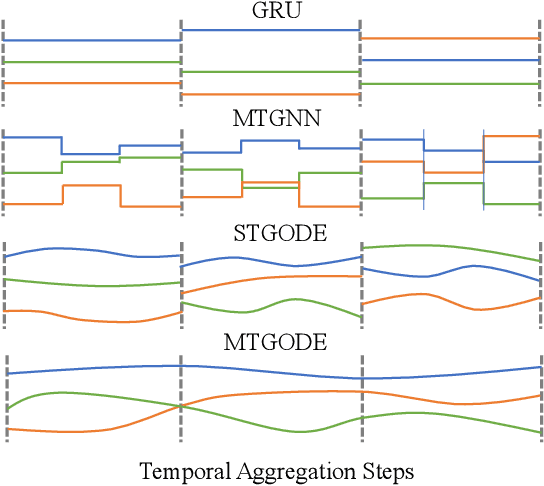


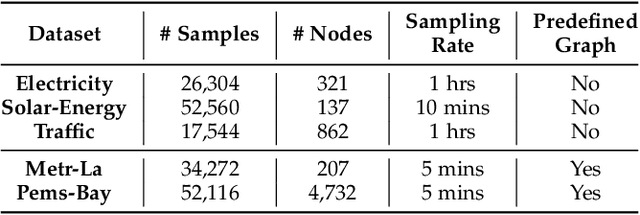
Abstract:Multivariate time series forecasting has long received significant attention in real-world applications, such as energy consumption and traffic prediction. While recent methods demonstrate good forecasting abilities, they suffer from three fundamental limitations. (i) Discrete neural architectures: Interlacing individually parameterized spatial and temporal blocks to encode rich underlying patterns leads to discontinuous latent state trajectories and higher forecasting numerical errors. (ii) High complexity: Discrete approaches complicate models with dedicated designs and redundant parameters, leading to higher computational and memory overheads. (iii) Reliance on graph priors: Relying on predefined static graph structures limits their effectiveness and practicability in real-world applications. In this paper, we address all the above limitations by proposing a continuous model to forecast Multivariate Time series with dynamic Graph neural Ordinary Differential Equations (MTGODE). Specifically, we first abstract multivariate time series into dynamic graphs with time-evolving node features and unknown graph structures. Then, we design and solve a neural ODE to complement missing graph topologies and unify both spatial and temporal message passing, allowing deeper graph propagation and fine-grained temporal information aggregation to characterize stable and precise latent spatial-temporal dynamics. Our experiments demonstrate the superiorities of MTGODE from various perspectives on five time series benchmark datasets.
From Unsupervised to Few-shot Graph Anomaly Detection: A Multi-scale Contrastive Learning Approach
Feb 11, 2022Abstract:Anomaly detection from graph data is an important data mining task in many applications such as social networks, finance, and e-commerce. Existing efforts in graph anomaly detection typically only consider the information in a single scale (view), thus inevitably limiting their capability in capturing anomalous patterns in complex graph data. To address this limitation, we propose a novel framework, graph ANomaly dEtection framework with Multi-scale cONtrastive lEarning (ANEMONE in short). By using a graph neural network as a backbone to encode the information from multiple graph scales (views), we learn better representation for nodes in a graph. In maximizing the agreements between instances at both the patch and context levels concurrently, we estimate the anomaly score of each node with a statistical anomaly estimator according to the degree of agreement from multiple perspectives. To further exploit a handful of ground-truth anomalies (few-shot anomalies) that may be collected in real-life applications, we further propose an extended algorithm, ANEMONE-FS, to integrate valuable information in our method. We conduct extensive experiments under purely unsupervised settings and few-shot anomaly detection settings, and we demonstrate that the proposed method ANEMONE and its variant ANEMONE-FS consistently outperform state-of-the-art algorithms on six benchmark datasets.
Towards Unsupervised Deep Graph Structure Learning
Jan 17, 2022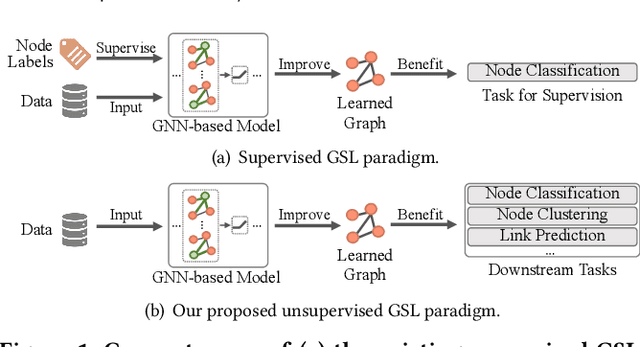
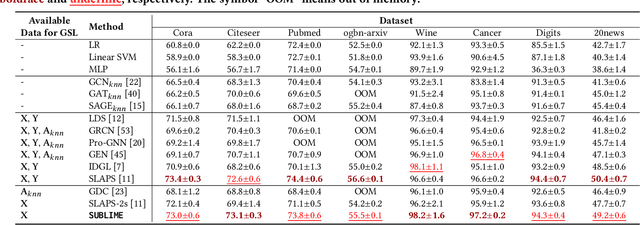

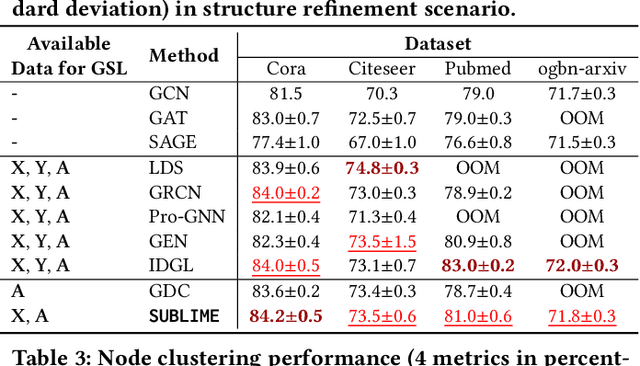
Abstract:In recent years, graph neural networks (GNNs) have emerged as a successful tool in a variety of graph-related applications. However, the performance of GNNs can be deteriorated when noisy connections occur in the original graph structures; besides, the dependence on explicit structures prevents GNNs from being applied to general unstructured scenarios. To address these issues, recently emerged deep graph structure learning (GSL) methods propose to jointly optimize the graph structure along with GNN under the supervision of a node classification task. Nonetheless, these methods focus on a supervised learning scenario, which leads to several problems, i.e., the reliance on labels, the bias of edge distribution, and the limitation on application tasks. In this paper, we propose a more practical GSL paradigm, unsupervised graph structure learning, where the learned graph topology is optimized by data itself without any external guidance (i.e., labels). To solve the unsupervised GSL problem, we propose a novel StrUcture Bootstrapping contrastive LearnIng fraMEwork (SUBLIME for abbreviation) with the aid of self-supervised contrastive learning. Specifically, we generate a learning target from the original data as an "anchor graph", and use a contrastive loss to maximize the agreement between the anchor graph and the learned graph. To provide persistent guidance, we design a novel bootstrapping mechanism that upgrades the anchor graph with learned structures during model learning. We also design a series of graph learners and post-processing schemes to model the structures to learn. Extensive experiments on eight benchmark datasets demonstrate the significant effectiveness of our proposed SUBLIME and high quality of the optimized graphs.
Crowd-sensing Enhanced Parking Patrol using Sharing Bikes' Trajectories
Oct 29, 2021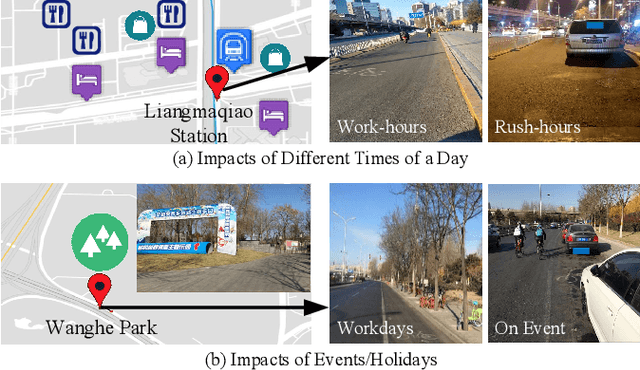
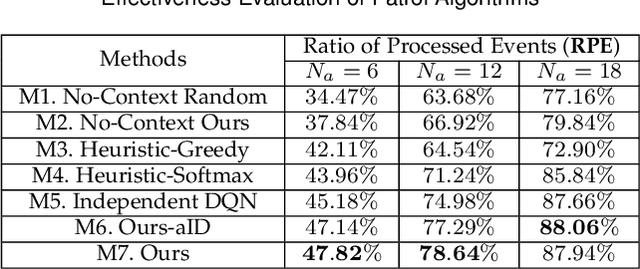
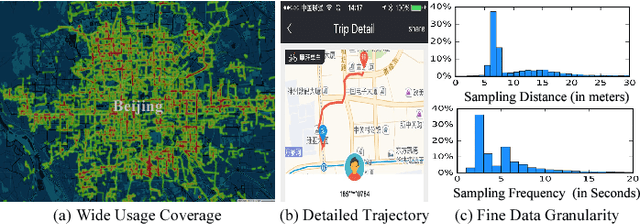

Abstract:Illegal vehicle parking is a common urban problem faced by major cities in the world, as it incurs traffic jams, which lead to air pollution and traffic accidents. The government highly relies on active human efforts to detect illegal parking events. However, such an approach is extremely ineffective to cover a large city since the police have to patrol over the entire city roads. The massive and high-quality sharing bike trajectories from Mobike offer us a unique opportunity to design a ubiquitous illegal parking detection approach, as most of the illegal parking events happen at curbsides and have significant impact on the bike users. The detection result can guide the patrol schedule, i.e. send the patrol policemen to the region with higher illegal parking risks, and further improve the patrol efficiency. Inspired by this idea, three main components are employed in the proposed framework: 1)~{\em trajectory pre-processing}, which filters outlier GPS points, performs map-matching, and builds trajectory indexes; 2)~{\em illegal parking detection}, which models the normal trajectories, extracts features from the evaluation trajectories, and utilizes a distribution test-based method to discover the illegal parking events; and 3)~{\em patrol scheduling}, which leverages the detection result as reference context, and models the scheduling task as a multi-agent reinforcement learning problem to guide the patrol police. Finally, extensive experiments are presented to validate the effectiveness of illegal parking detection, as well as the improvement of patrol efficiency.
Rep Works in Speaker Verification
Oct 19, 2021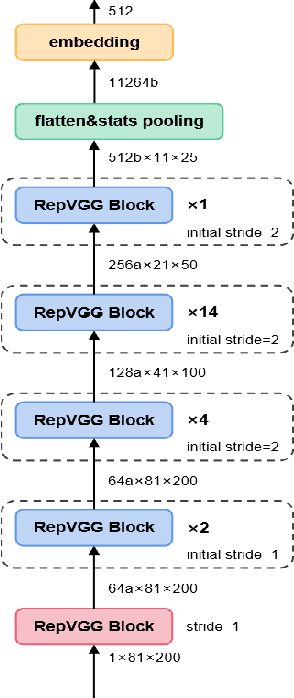
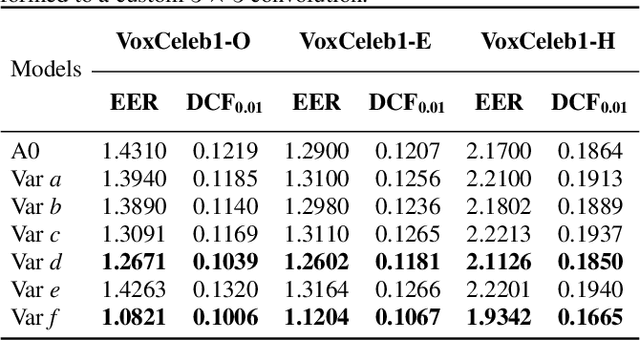
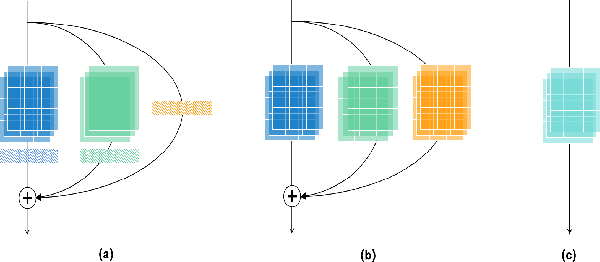
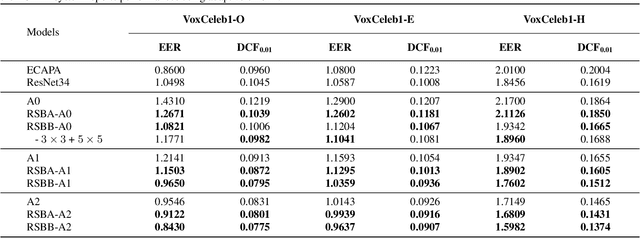
Abstract:Multi-branch convolutional neural network architecture has raised lots of attention in speaker verification since the aggregation of multiple parallel branches can significantly improve performance. However, this design is not efficient enough during the inference time due to the increase of model parameters and extra operations. In this paper, we present a new multi-branch network architecture RepSPKNet that uses a re-parameterization technique. With this technique, our backbone model contains an efficient VGG-like inference state while its training state is a complicated multi-branch structure. We first introduce the specific structure of RepVGG into speaker verification and propose several variants of this structure. The performance is evaluated on VoxCeleb-based test sets. We demonstrate that both the branch diversity and the branch capacity play important roles in RepSPKNet designing. Our RepSPKNet achieves state-of-the-art performance with a 1.5982% EER and a 0.1374 minDCF on VoxCeleb1-H.
Multi-query multi-head attention pooling and Inter-topK penalty for speaker verification
Oct 12, 2021
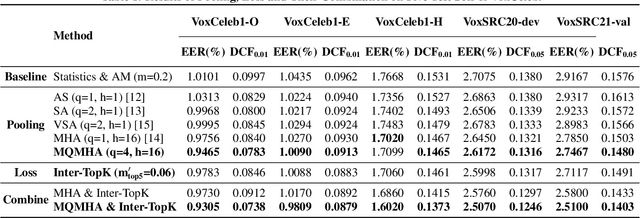
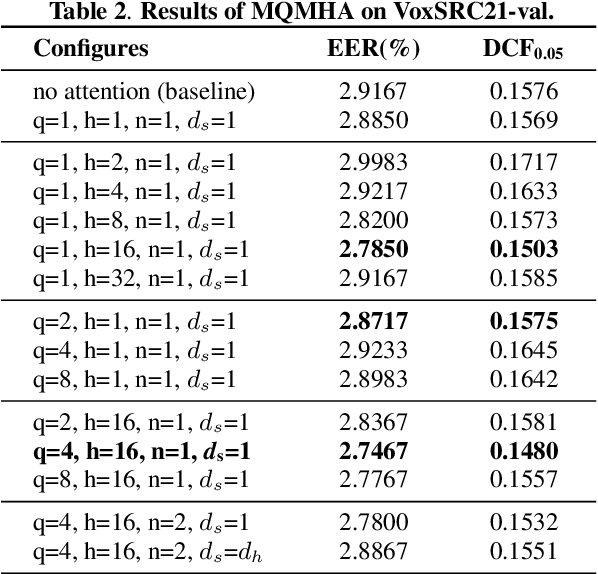
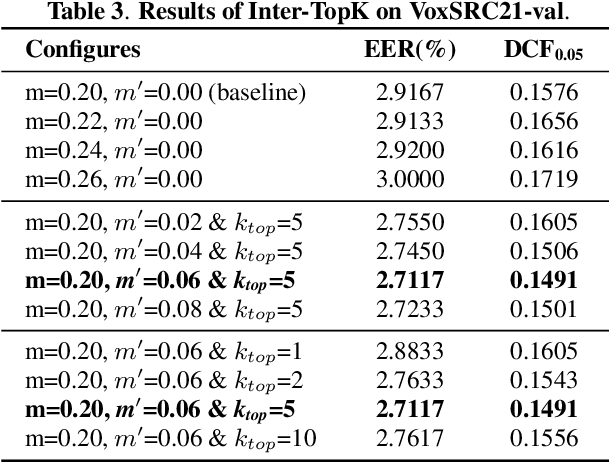
Abstract:This paper describes the multi-query multi-head attention (MQMHA) pooling and inter-topK penalty methods which were first proposed in our submitted system description for VoxCeleb speaker recognition challenge (VoxSRC) 2021. Most multi-head attention pooling mechanisms either attend to the whole feature through multiple heads or attend to several split parts of the whole feature. Our proposed MQMHA combines both these two mechanisms and gain more diversified information. The margin-based softmax loss functions are commonly adopted to obtain discriminative speaker representations. To further enhance the inter-class discriminability, we propose a method that adds an extra inter-topK penalty on some confused speakers. By adopting both the MQMHA and inter-topK penalty, we achieved state-of-the-art performance in all of the public VoxCeleb test sets.
Poformer: A simple pooling transformer for speaker verification
Oct 10, 2021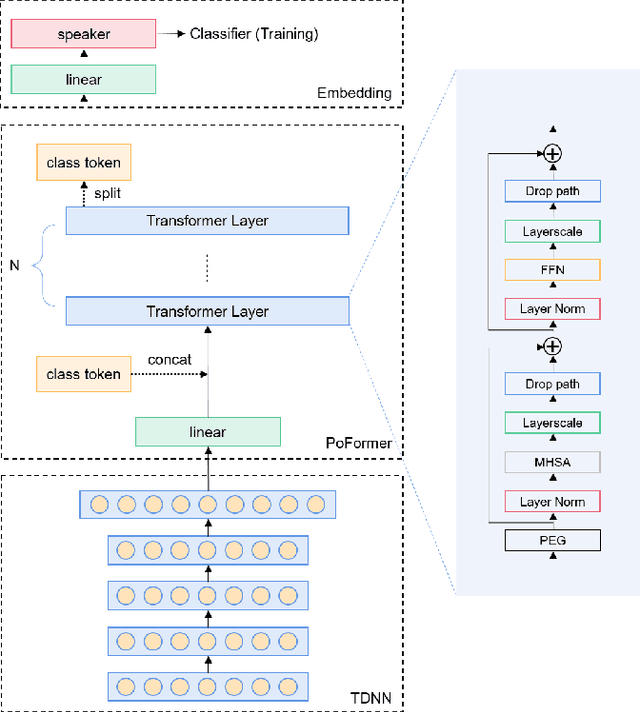

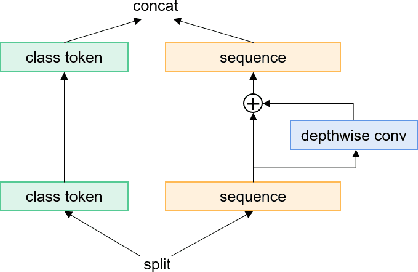
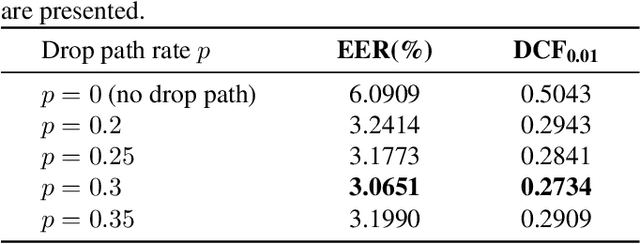
Abstract:Most recent speaker verification systems are based on extracting speaker embeddings using a deep neural network. The pooling layer in the network aims to aggregate frame-level features extracted by the backbone. In this paper, we propose a new transformer based pooling structure called PoFormer to enhance the ability of the pooling layer to capture information along the whole time axis. Different from previous works that apply attention mechanism in a simple way or implement the multi-head mechanism in serial instead of in parallel, PoFormer follows the initial transformer structure with some minor modifications like a positional encoding generator, drop path and LayerScale to make the training procedure more stable and to prevent overfitting. Evaluated on various datasets, PoFormer outperforms the existing pooling system with at least a 13.00% improvement in EER and a 9.12% improvement in minDCF.
Traffic Flow Forecasting with Spatial-Temporal Graph Diffusion Network
Oct 08, 2021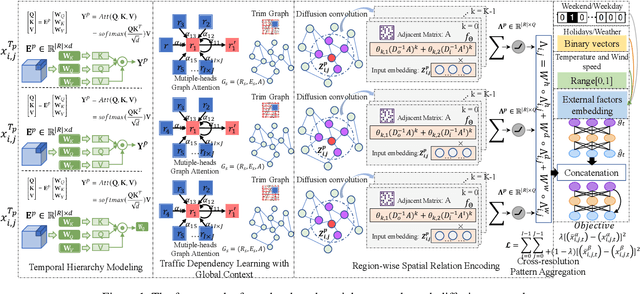


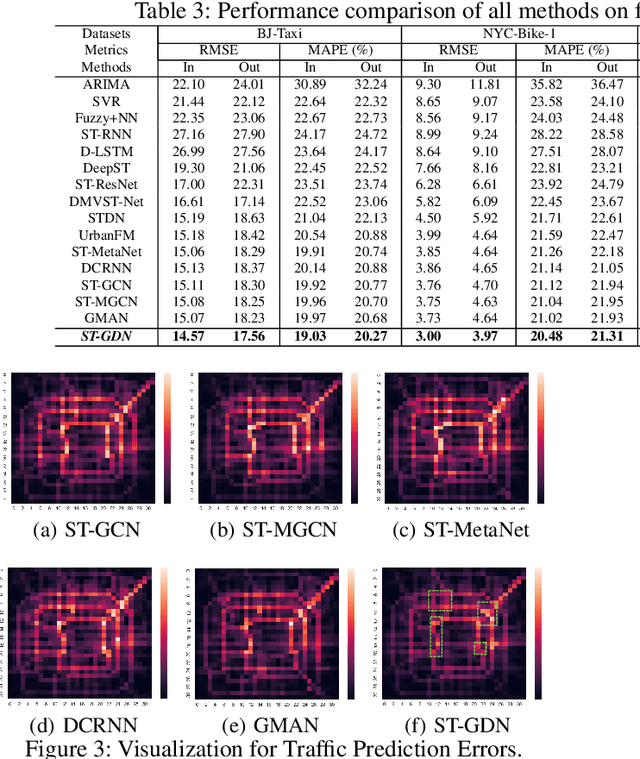
Abstract:Accurate forecasting of citywide traffic flow has been playing critical role in a variety of spatial-temporal mining applications, such as intelligent traffic control and public risk assessment. While previous work has made significant efforts to learn traffic temporal dynamics and spatial dependencies, two key limitations exist in current models. First, only the neighboring spatial correlations among adjacent regions are considered in most existing methods, and the global inter-region dependency is ignored. Additionally, these methods fail to encode the complex traffic transition regularities exhibited with time-dependent and multi-resolution in nature. To tackle these challenges, we develop a new traffic prediction framework-Spatial-Temporal Graph Diffusion Network (ST-GDN). In particular, ST-GDN is a hierarchically structured graph neural architecture which learns not only the local region-wise geographical dependencies, but also the spatial semantics from a global perspective. Furthermore, a multi-scale attention network is developed to empower ST-GDN with the capability of capturing multi-level temporal dynamics. Experiments on several real-life traffic datasets demonstrate that ST-GDN outperforms different types of state-of-the-art baselines. Source codes of implementations are available at https://github.com/jill001/ST-GDN.
Graph Neural Networks for Recommender Systems: Challenges, Methods, and Directions
Sep 27, 2021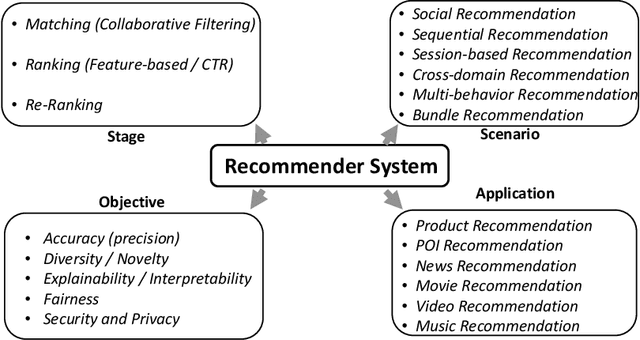
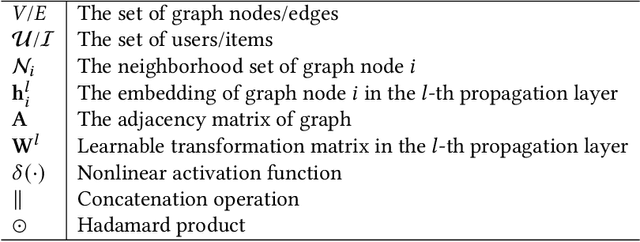
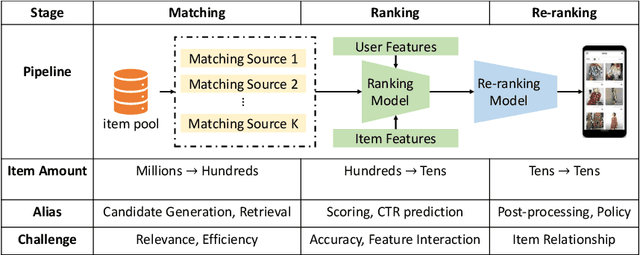
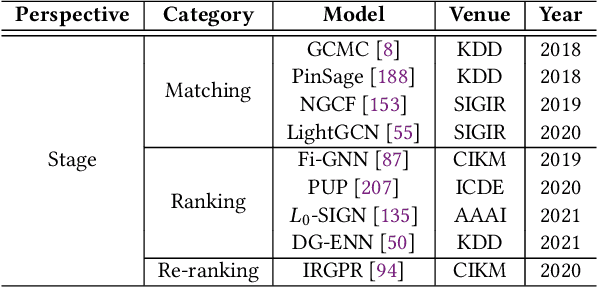
Abstract:Recommender system is one of the most important information services on today's Internet. Recently, graph neural networks have become the new state-of-the-art approach of recommender systems. In this survey, we conduct a comprehensive review of the literature in graph neural network-based recommender systems. We first introduce the background and the history of the development of both recommender systems and graph neural networks. For recommender systems, in general, there are four aspects for categorizing existing works: stage, scenario, objective, and application. For graph neural networks, the existing methods consist of two categories, spectral models and spatial ones. We then discuss the motivation of applying graph neural networks into recommender systems, mainly consisting of the high-order connectivity, the structural property of data, and the enhanced supervision signal. We then systematically analyze the challenges in graph construction, embedding propagation/aggregation, model optimization, and computation efficiency. Afterward and primarily, we provide a comprehensive overview of a multitude of existing works of graph neural network-based recommender systems, following the taxonomy above. Finally, we raise discussions on the open problems and promising future directions of this area. We summarize the representative papers along with their codes repositories in https://github.com/tsinghua-fib-lab/GNN-Recommender-Systems.
POI Alias Discovery in Delivery Addresses using User Locations
Sep 20, 2021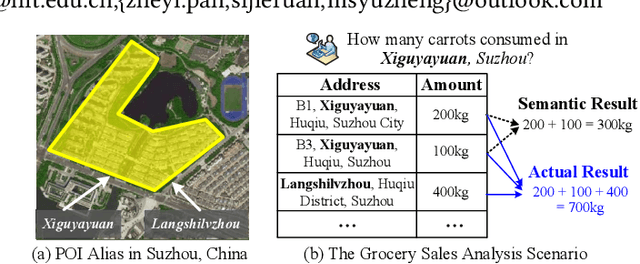
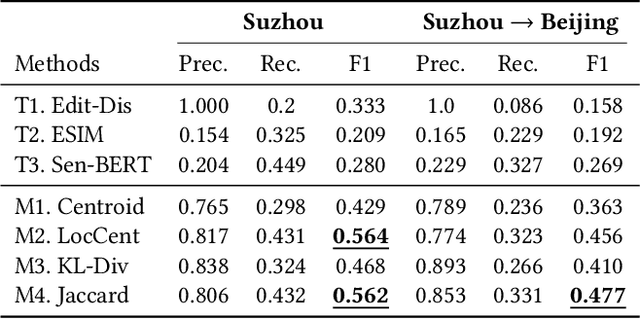
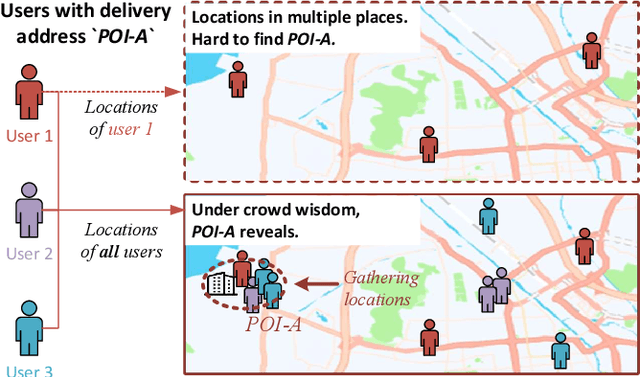
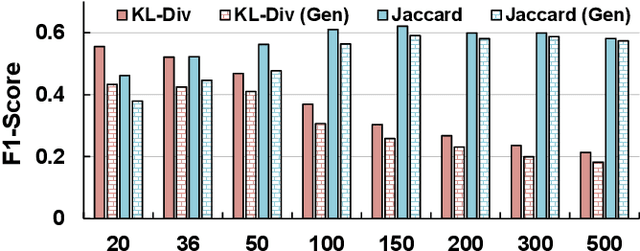
Abstract:People often refer to a place of interest (POI) by an alias. In e-commerce scenarios, the POI alias problem affects the quality of the delivery address of online orders, bringing substantial challenges to intelligent logistics systems and market decision-making. Labeling the aliases of POIs involves heavy human labor, which is inefficient and expensive. Inspired by the observation that the users' GPS locations are highly related to their delivery address, we propose a ubiquitous alias discovery framework. Firstly, for each POI name in delivery addresses, the location data of its associated users, namely Mobility Profile are extracted. Then, we identify the alias relationship by modeling the similarity of mobility profiles. Comprehensive experiments on the large-scale location data and delivery address data from JD logistics validate the effectiveness.
 Add to Chrome
Add to Chrome Add to Firefox
Add to Firefox Add to Edge
Add to Edge